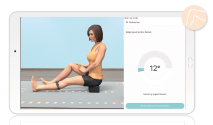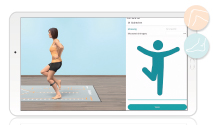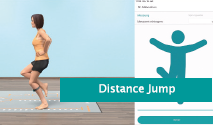
Digital screening via a sensor and app for function-based aftercare - Orthelligent is a practical, location-independent and cost-effective measuring system that is used for prevention and rehabilitation. It uses different tests to analyse certain motion sequences and displays the results graphically. In this way, the current actual state can be determined, both after an injury and during normal training.
Your advantages
- Comparison of healthy and injured leg
- Monitoring the patient’s personal healing progression
- Patients better informed and more motivated
- Quality of result is ensured
- Evaluate test results locally on tablet in the cloud
- Suitable for implementing function-based post treatment every day
Small sensor - big impact
The Orthelligent movement sensor analyses movement sequences on the lower extremities while the connected app evaluates the results and displays them in graphic form. These evaluations provide more precise conclusions about the healing process after a knee or ankle injury. The app evalutes the results from the different tests and compares the patient’s healthy leg to the injured one. The Orthelligent Pro app guides the patient through the different movement tests, which are then evaluated immediately. This allows you as the physician or therapist to draw conclusions on the development of certain motor functions, for example. This insight helps with keeping an eye on the recovery progress and the effect of treatment methods used. Another development of the app now makes it possible to manage any number of patients in a data base.

More Information

Do you have any questions about Orthelligent Pro?
We will be happy to advise you!
Please contact us
- +49 8024 - 60-818-210
- mail@oped.de

"The application is simple and fast."
"“We treat a great number of patients with knee complaints in our practice. In the course of this we keep a rehabilitation log based on science and field-tested, which contains the various tests for assessing current capability. With the OPED sensor, we can collect this data precisely in a short time. Application is easy and goes quickly so that there is still enough time for therapy and training for the patient. The customer is also more motivated in training when they can track their performance progress via an app.”"
- Dr. Tanja Hohmann, Physio-Konzept Praxis Stadionbad, Köln -
What is measured?
The current tests are grouped into three categories: Range of movement, co-ordination and strength/speed. The tests may be carried out at different times.
Range of motion
The range of motion of a joint is measured in degrees. In the case of the knee joint, the full extension is described as 0 degrees and is important for the natural gait. The max. flexion is on average 130°. In younger people, it is up to 160°. A human, for example, needs a flexion up to 70° to walk on a normal flat surface. For climbing stairs, a flexion of 80 to 90° is required. 120° flexion are required so you can get out of a deep chair or stand up from a toilet seat. A minimum of 110° is required for cycling.
Coordination
Coordination is the ability to control and harmonise movements. This must often be re-learned after an injury. Balance and the sensitivity to depth are important for correct muscle control. These senses must be mastered again before the next phase of strength/endurance can begin.
Strength/Speed
If an athlete wants to go back to playing his sport after an injury, strength/quickness is especially important here. Here the possible deficits can be pointed out in order to, among other things, prevent another injury.
All test videos at a glance
More Information

Do you have any questions about Orthelligent Pro?
We will be happy to advise you!
Please contact us
- +49 8024 - 60-818-210
- mail@oped.de
Package selection
Buy Orthelligent Pro with extensive client management for your practice - no matter whether as a doctor, physiotherapist or fitness trainer. There are three different packages to choose from.
Starter Package

Standard Package

Professional Package


"With Orthelligent Pro from OPED..."
"... we are able to document our therapeutic success in physiotherapy and medical training therapy in no time, in a way that is science-based and future-oriented. It helps us identify shortcomings in the patient and deal with them uniquely. A tool that is absolutely essential to modern knee rehabilitation."
- Oliver Kurz, Geschäftsführer, OKPHYSIO therapie & training GmbH -
Studies on the effectiveness of Return to Sports - Measurements
- Simple decision rules can reduce reinjury risk by 84% after ACL reconstruction: the Delaware-Oslo ACL cohort study
- Likelihood of ACL graft rupture: not meeting six clinical discharge criteria before return to sport is associated with a four times greater risk of rupture
- A conceptual framework for a sports knee injury performance profile (SKIPP) and return to activity criteria (RTAC)
- Incidence of Second ACL Injuries 2 Years After Primary ACL Reconstruction and Return to Sport.
- Younger patients are at increased risk for graft rupture and contralateral injury after anterior cruciate ligament reconstruction.
- The epidemiology of anterior cruciate ligament injury in football (soccer): A review of the literature from a gender-related perspective
- Return to sport following anterior cruciate ligament reconstruction surgery: a systematic review and meta-analysis of the state of play
- Functional assessments for decision-making regarding return to sports following ACL reconstruction. Part II: clinical application of a new test battery
- Optimization of the Return-to-Sport Paradigm After Anterior Cruciate Ligament Reconstruction: A Critical Step Back to Move Forward.
More Information

Do you have any questions about Orthelligent Pro?
We will be happy to advise you!
Please contact us
- +49 8024 - 60-818-210
- mail@oped.de
































